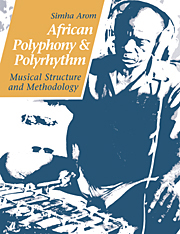Book contents
- Frontmatter
- Contents
- List of illustrations
- Foreword by György Ligeti
- Preface
- Acknowledgements
- BOOK I THE MUSIC OF THE CENTRAL AFRICAN REPUBLIC
- BOOK II AFRICAN POLYPHONIC MUSIC
- BOOK III TECHNICAL TOOLS: METHODS OF RECORDING POLYPHONIC MUSIC FOR TRANSCRIPTION
- 1 The need for transcription
- 2 The difficulties of transcription
- 3 Earlier methods
- 4 Towards a new method
- 5 Theoretical assumptions
- 6 Technical equipment: description and use
- 7 From recording to transcription
- 8 Checking the results
- 9 Potentialities
- 10 Anthropological validity
- BOOK IV THEORETICAL TOOLS
- BOOK V THE ORGANISATION OF TIME IN AFRICAN MUSIC
- BOOK VI STRUCTURAL PRINCIPLES AND THEIR APPLICATION
- Conclusion
- Bibliography
8 - Checking the results
Published online by Cambridge University Press: 27 January 2010
- Frontmatter
- Contents
- List of illustrations
- Foreword by György Ligeti
- Preface
- Acknowledgements
- BOOK I THE MUSIC OF THE CENTRAL AFRICAN REPUBLIC
- BOOK II AFRICAN POLYPHONIC MUSIC
- BOOK III TECHNICAL TOOLS: METHODS OF RECORDING POLYPHONIC MUSIC FOR TRANSCRIPTION
- 1 The need for transcription
- 2 The difficulties of transcription
- 3 Earlier methods
- 4 Towards a new method
- 5 Theoretical assumptions
- 6 Technical equipment: description and use
- 7 From recording to transcription
- 8 Checking the results
- 9 Potentialities
- 10 Anthropological validity
- BOOK IV THEORETICAL TOOLS
- BOOK V THE ORGANISATION OF TIME IN AFRICAN MUSIC
- BOOK VI STRUCTURAL PRINCIPLES AND THEIR APPLICATION
- Conclusion
- Bibliography
Summary
Conducting research in this way under experimental conditions calls for extreme caution. That is why checks and controls must be included in our procedure and applied throughout the experimental process. Brief reference has already been made to one kind of check, namely, the fact that headsets are provided to enable various people to monitor the recording operation: the musicians, the head musician (where the function of leader exists), the masters, and the elders, all of whom have an intimate knowledge of the music from having been involved in it. They listen through their headphones to all the individual performers being recorded. The investigator must maintain constant visual contact with them so that, if they object to any musical event, he will see their opinion reflected with such speed and clarity on their faces that he will immediately know there has been a mistake. If the investigator himself thinks he has heard something wrong during the performance, he can direct a questioning glance at them, and they will either confirm his impression or let him know that everything is as it should be. Clearly, this constant questioning of the accuracy of the output in no way relies on the investigator's theoretical assumptions, but is based entirely on the proper of improper performance of musical material within a given group, i.e., on culturally relevant criteria.
There is a second sort of checking procedure built into the method. If a musician makes a mistake which gets by even the kind of monitoring described above, yet is serious enough to affect the coherent musical organisation of the piece, the next musician to record, who uses the erroneous part as a reference, will obviously be bothered by it in his own performance.
- Type
- Chapter
- Information
- African Polyphony and PolyrhythmMusical Structure and Methodology, pp. 114 - 115Publisher: Cambridge University PressPrint publication year: 1991

